
Arachnids are arthropods in the class Arachnida of the subphylum Chelicerata. Arachnida includes, among others, spiders, scorpions, ticks, mites, pseudoscorpions, harvestmen, camel spiders, whip spiders and vinegaroons.

The Opiliones are an order of arachnids colloquially known as harvestmen, harvesters, harvest spiders, or daddy longlegs. As of April 2017, over 6,650 species of harvestmen have been discovered worldwide, although the total number of extant species may exceed 10,000. The order Opiliones includes five suborders: Cyphophthalmi, Eupnoi, Dyspnoi, Laniatores, and Tetrophthalmi, which were named in 2014.

Ricinulei is a small order of arachnids. Like most arachnids, they are predatory, eating small arthropods. They occur today in west-central Africa (Ricinoides) and the Americas as far north as Texas. As of 2021, 91 extant species of ricinuleids have been described worldwide, all in the single family Ricinoididae. In older works they are sometimes referred to as Podogona. Due to their obscurity they do not have a proper common name, though in academic literature they are occasionally referred to as hooded tickspiders.

The Pholcidae are a family of araneomorph spiders. The family contains more than 1,800 individual species of pholcids, including those commonly known as cellar spider, daddy long-legs spider, carpenter spider, daddy long-legger, vibrating spider, gyrating spider, long daddy, and skull spider. The family, first described by Carl Ludwig Koch in 1850, is divided into 94 genera.
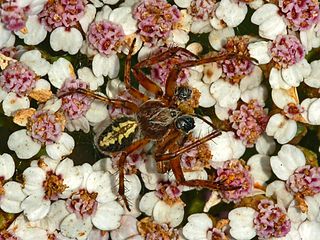
Aculepeira ceropegia, the oak spider, is an orb-weaving spider species belonging to the family Araneidae.

Saitis barbipes is a common jumping spider found in the Mediterranean region.

Cyphophthalmi is a suborder of harvestmen, colloquially known as mite harvestmen. Cyphophthalmi comprises 36 genera, and more than two hundred described species. The six families are currently grouped into three infraorders: the Boreophthalmi, Scopulophthalmi, and Sternophthalmi.
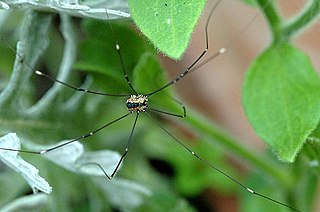
Leiobunum rotundum is a species of harvestman that is found within the western portion of the Old World.
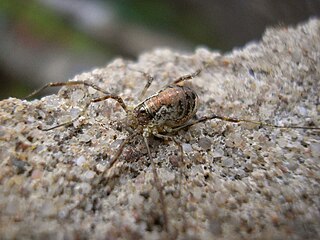
Paroligolophus agrestis is a species of harvestman. It occurs in Europe, including the United Kingdom, and has been introduced to North America in the Pacific Northwest and Nova Scotia.

Phalangium opilio is a species of harvestman belonging to the family Phalangiidae.

Nipponopsalididae is a family of harvestmen with three described species in one genus, Nipponopsalis, which is found in East Asia.
The Cokendolpher cave harvestman, Texella cokendolpheri, is a species of cave-living harvestman native to Bexar County, Texas. The original common name, the Robber Baron Cave harvestman, stemmed from the cave which the harvestman inhabits. The scientific name and the current common name honor the prominent arachnologist, James Cokendolpher, who identified the species. T. cokendolpheri is one of twenty-eight species within the North American harvestman genus Texella. The first formal description of the harvestman took place in 1992 and the species’ listing under the Endangered Species Act followed eight years later. Current threats to the species include habitat loss and interactions with invasive fire ants.
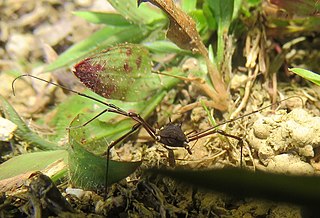
Quindina albomarginis is a species of Neotropical harvestman in the order Opiliones. It is found in the tropical forests of Panama.

Trogulus tricarinatus is a species of harvestman. It is found in Europe and North America.
Huitaca boyacaensis is a species of neotropical harvestmen in the family Neogoveidae, first described by Ligia Benavides and Gonzalo Giribet in 2013.

Ebrechtella tricuspidata is a species of crab spiders belonging to the family Thomisidae.

Dasylobus argentatus is a species of harvestman in the family Phalangiidae.
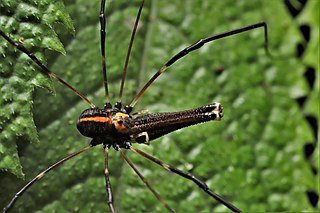
Forsteropsalis pureora is a species of long-legged harvestman in the family Neopilionidae. This species is endemic to New Zealand, found in the North Island. They are found in native forest, often resting on vegetation or stream banks.

Forsteropsalis photophaga, also known as the glow-worm hunter, is a species of long-legged harvestman in the family Neopilionidae. This species is endemic to New Zealand, found in North Island caves in the vicinity of Waitomo. The name "photophaga" comes from their habit of feeding on the luminescent larvae, pupae, and adults of the New Zealand glow-worm Arachnocampa luminosa.


















